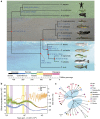Mudskipper genomes provide insights into the terrestrial adaptation of amphibious fishes
- PMID: 25463417
- PMCID: PMC4268706
- DOI: 10.1038/ncomms6594
Mudskipper genomes provide insights into the terrestrial adaptation of amphibious fishes
Abstract
Mudskippers are amphibious fishes that have developed morphological and physiological adaptations to match their unique lifestyles. Here we perform whole-genome sequencing of four representative mudskippers to elucidate the molecular mechanisms underlying these adaptations. We discover an expansion of innate immune system genes in the mudskippers that may provide defence against terrestrial pathogens. Several genes of the ammonia excretion pathway in the gills have experienced positive selection, suggesting their important roles in mudskippers' tolerance to environmental ammonia. Some vision-related genes are differentially lost or mutated, illustrating genomic changes associated with aerial vision. Transcriptomic analyses of mudskippers exposed to air highlight regulatory pathways that are up- or down-regulated in response to hypoxia. The present study provides a valuable resource for understanding the molecular mechanisms underlying water-to-land transition of vertebrates.
Figures



Similar articles
-
Genomics comparisons of three chromosome-level mudskipper genome assemblies reveal molecular clues for water-to-land evolution and adaptation.J Adv Res. 2024 Apr;58:93-104. doi: 10.1016/j.jare.2023.05.005. Epub 2023 May 21. J Adv Res. 2024. PMID: 37220853 Free PMC article.
-
Mudskippers and Their Genetic Adaptations to an Amphibious Lifestyle.Animals (Basel). 2018 Feb 7;8(2):24. doi: 10.3390/ani8020024. Animals (Basel). 2018. PMID: 29414871 Free PMC article. Review.
-
Transcriptomic evidence of adaptive tolerance to high environmental ammonia in mudskippers.Genomics. 2018 Nov;110(6):404-413. doi: 10.1016/j.ygeno.2018.09.001. Epub 2018 Sep 24. Genomics. 2018. PMID: 30261316
-
Alkaline environmental pH has no effect on ammonia excretion in the mudskipper Periophthalmodon schlosseri but inhibits ammonia excretion in the related species Boleophthalmus boddaerti.Physiol Biochem Zool. 2003 Mar-Apr;76(2):204-14. doi: 10.1086/374281. Physiol Biochem Zool. 2003. PMID: 12794674
-
Five tropical air-breathing fishes, six different strategies to defend against ammonia toxicity on land.Physiol Biochem Zool. 2004 Sep-Oct;77(5):768-82. doi: 10.1086/422057. Physiol Biochem Zool. 2004. PMID: 15547795 Review.
Cited by
-
The Genome 10K Project: a way forward.Annu Rev Anim Biosci. 2015;3:57-111. doi: 10.1146/annurev-animal-090414-014900. Annu Rev Anim Biosci. 2015. PMID: 25689317 Free PMC article. Review.
-
Decoding the fish genome opens a new era in important trait research and molecular breeding in China.Sci China Life Sci. 2024 Oct;67(10):2064-2083. doi: 10.1007/s11427-023-2670-5. Epub 2024 Aug 12. Sci China Life Sci. 2024. PMID: 39145867 Review.
-
A Comparative Metagenomics Study on Gastrointestinal Microbiota in Amphibious Mudskippers and Other Vertebrate Animals.Animals (Basel). 2019 Sep 6;9(9):660. doi: 10.3390/ani9090660. Animals (Basel). 2019. PMID: 31489883 Free PMC article.
-
Molecular evolution of the hemoglobin gene family across vertebrates.Genetica. 2023 Jun;151(3):201-213. doi: 10.1007/s10709-023-00187-9. Epub 2023 Apr 17. Genetica. 2023. PMID: 37069365
-
The genome of walking catfish Clarias magur (Hamilton, 1822) unveils the genetic basis that may have facilitated the development of environmental and terrestrial adaptation systems in air-breathing catfishes.DNA Res. 2021 Jan 19;28(1):dsaa031. doi: 10.1093/dnares/dsaa031. DNA Res. 2021. PMID: 33416875 Free PMC article.
References
-
- Ishimatsu A. & Gonzales T. T. inThe Biology of Gobies (eds Patzner R.et al.)609–638Science Publishers (2011).
-
- Gianluca P. & Giuseppe C. Multivariate characterisation of the habitats of seven species of Malayan mudskippers (Gobiidae: Oxudercinae). Mar. Biol. 156, 1475–1486 (2009).
-
- Baeck G., Takita T. & Yoon Y. Lifestyle of Korean mudskipper Periophthalmus magnuspinnatus with reference to a congeneric species Periophthalmus modestus. Ichthyol. Res. 55, 43–52 (2008).
Publication types
MeSH terms
Substances
Grants and funding
LinkOut - more resources
Full Text Sources
Other Literature Sources
Molecular Biology Databases

